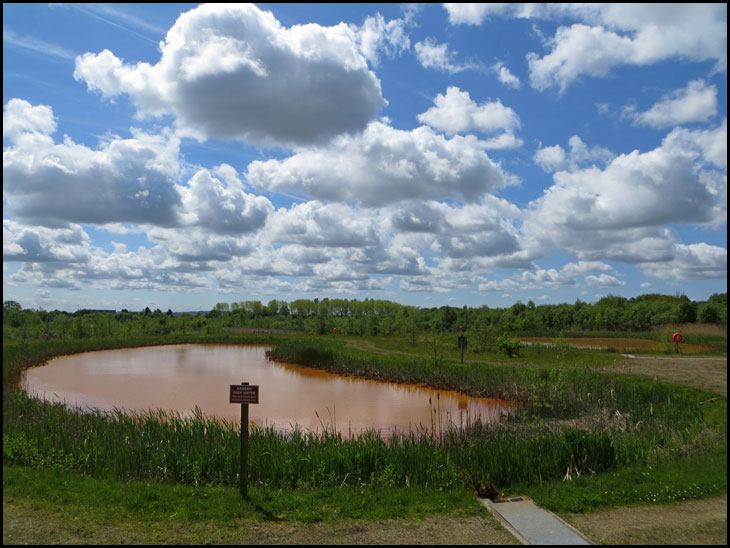Photo-a-Day (Friday, 14th June, 2013)
Why the 'Yellow brook ain't yellow any more'
Wow! i love the sky in this photo!
David .Tell me .How can these tanks clean water upstream from them.How can they clean water coming out of the ground up stream?? That water was becoming clean 10 to 15 years ago. .My pic was taken upstream.
Yes Kath.....wonderful sky.....and green, green grass.....nice one David......cheers!!!
Thanks Kath, it was a lovely day.
Hi Ron. My photo was taken at the Aspull Sough mine treatment scheme which is behind Canon Sharples school. As I understand it the water comes out of the mine and into the filtration ponds. The cleaner filtered water then flows out of the filtration ponds into the yellow brook down through the woods and into the the River Douglas. The filtration ponds were finished around 2004.
Ron
Could be that the pigmentation of the emergent water was decreasing as the amount of soluble iron salts that the water came into contact with began to get more washed out. Thought there does seem to be plenty of pigment still in the water in the photo.
BTW Although a fair amount of information can be found in print, concerning the Great Haigh Sough which feeds yellow brook, does anyone have any information on the nearby Gerard's Sough?
Info about the Sough at http://en.wikipedia.org/wiki/Great_Haigh_Sough#CITEREFDavies2010
In 2004 the Coal Authority provided a passive treatment plant in a scheme costing £750.000. Work was undertaken by Ascot Environmental who built a pumping station, pipelines, settlement lagoons, reedbeds and landscaped the site. The scheme has improved the water quality, removed manganese and iron which caused the discolouration and allowed fish to repopulate the brook.
Regarding Gerard's Sough: the following is probably related, but it is not explicit:
Committee for Compounding with Delinquents.
Cases before the Committee, May 1646, 01 May 1646-31 May 1646
8 94 11 Dec. 1651. Thos. Gerard, jun., petitions that he has a delph or mine of cannel coal in Aspull, which he could not work without digging a trench through the land of [Jas. ] Gorsuch, a delinquent, to ...
Also need to see:
https://en.wikipedia.org/wiki/Committee_for_Compounding_with_Delinquents
A bit of info which may be of interest to some:
The Lancashire Gentry and the Great Rebellion, 1640-60
...John Braddyll of Portfield was outlawed for debt in 1663,and one reason may have been that during the previous eleven years he had 'made divers shafts and colepitts' and had 'bestowed £300 or thereabouts for the making of a sough'. Thomas Charnock apparently invested several hundreds of pounds in his Bradford colliery under James I. This may partly explain his heavy debts and
land sales under Charles I. The Gerards of Ince were even greater gamblers and adventurers, for they apparently invested £3,000 in their cannel mine at Aspull. Such heavy expenditure may possibly explain why their debts were between £1,244 and £2,000. These were heavy burdens for a Family whose annual income was probably only about £250 in 1641. Thus it would seem that for the Lancashire gentry coal mining was a highly precarious source of wealth.
Thanks Neil
There is a map of the Soughs in this area in book 'Wigan Coal and Iron', by Donald Anderson and AA France.
It shows Gerard's Sough about 1000 yards South of Bradshaigh's Sough, which is the original section of what became The Great Haigh Sough.
It shows the Six mines that it drained, and the outlet into Clarington Brook, but gives no further information.
Cheers Lizzie :)
